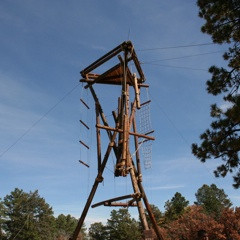Many had gone before me, but I was a skeptic. I remember asking my boss what I could learn from climbing up a 40-foot tall post, balancing on a small platform and then jumping off? It didn’t seem relevant at the time. In the deep woods of Arkansas, I was proven wrong.Recent estimates by builders on the ropes-online listserv estimate that there are more than 7,500 challenge courses in the USA and that an additional 200 to 400 are built each year. The course developed by Gary Gore of Team Trek, located in the peaceful Ozark foothills, provides a stand out experience.
After Gore’s many executive assignments in grain marketing and transportation corporations, he realized he had a knack for building better leaders and connecting teams. He wanted to help people focus on personal development. The rolling hills surrounding Greer´s Ferry Lake in Heber Springs, Arkansas provided the solitude to focus with limited interruptions from the outside world. The standard curriculum of any low or high ropes course focuses on trust, communication and teamwork. Gary takes a step further; he uses these surroundings to identify strengths and weaknesses and to build toward a life plan to help you become a better leader.
Day one, first meeting. We had to tell the group what type of animal we were. I said I was the beaver; I’m a builder and a problem solver and I don’t need a lot to get the job done. Then, a longtime colleague next to me told the group he is a shark and will stop at nothing to get what he wants, is vigilant in the hunt, enjoys the kill and likes to be feared. This led to a three-hour discussion about the definition of a good leader and allowed us to understand our own leadership DNA.
Day two. The lessons throughout the week continued to unveil a set of leadership principles that Gore developed and published in his book, Navigating Change. Improving trust and communication within a team is a tall order. Good leaders need to understand underlying leadership skills and, when new to these techniques, get the chance to practice in a safe environment. Gary facilitates this process by wrapping workshops around principles such as “100% responsibility.” He encourages everyone to acknowledge such points as, “I am 100% responsible for how I choose to respond to the people and circumstances in my life. Everyone else is 0% responsible.”
Day three. We woke early for a hike to infamous 40-foot tall pole. Lives had been changing in front of my eyes throughout the week. The “shark” was softening. Strong leaders were emerging, but really – how was a single jump going to further this transformation? I didn’t even have to jump to answer that question. My first job that day as the belayer, the climber, relied on me to keep the safety rope taut and to catch others if they fell. The encouragement of everyone on our team for each team member poured out in screaming, clapping and shouted directions. As soon as one of us had made it, we had to ensure the whole team made it. My climb and jump will stick in my mind forever. I have the picture on my desk to this day, five years later, as a leadership token to remind me of that day.
The bottom line? Leadership can be taught and every leader has room to grow.
Keep up-to-date with Fast Track Tools by subscribing to our blog, via Twitter @fasttracktools and join our Facebook community!
After completing the Communicate to Win workshop, you will have the most compelling argument and the best ideas. With this complete package, you will gain the tools necessary to guarantee that you have the best ideas and that you can present them confidently so you will WIN. Read what participants say.
photo by Katrina Snaps. Used by permission.
